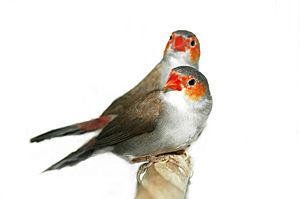Orange-cheeked waxbill facts for kids
Quick facts for kids Orange-cheeked waxbill |
|
|---|---|
 |
|
| Conservation status | |
| Scientific classification |
The orange-cheeked waxbill (Estrilda melpoda) is a small, colorful bird. It is a type of estrildid finch. These birds are very common in western and central Africa. They live across a huge area, about 3.6 million square kilometers!
Contents
About the Orange-Cheeked Waxbill
Orange-cheeked waxbills often live in small family groups. Sometimes, they gather in bigger flocks of thirty or more birds. You can often tell they are nearby by their high-pitched peep sounds.
Like many finches, these birds are very good at moving around. They can climb up and down grass stems and twigs. They even hang upside down while they are eating! Male waxbills usually have brighter orange patches on their cheeks.
What Do They Eat?
These birds mainly eat tiny grass seeds. They find seeds on the ground or pick them directly from grass panicles (the seed heads). They might hang onto the stems to get ripe or green seeds.
During the time they are raising their young, they also eat small insects. This includes termites, aphids, and gnats.
Life Cycle
Orange-cheeked waxbills like to build their nests close to the ground. They often choose thick clumps of tall grass. They pull together nearby grass stems and old seed heads. This helps to hide their nest very well.
Inside the nest, they use fine white feathers to make it soft. The female bird lays three to six tiny white eggs. The parents sit on the eggs for about 13 days until they hatch. Young birds, called fledglings, leave the nest after about 23 days. They look a lot like their parents. However, their orange cheek patches are not as bright for the first few months.
Where Do They Live?
These birds first came from Western Africa. They live in open grasslands with some trees or bushes. You can also find them near rivers, in gardens, and on farms. They are common in dry areas called savannahs.
Orange-cheeked waxbills are found in many countries. These include Angola, Benin, Burkina Faso, Burundi, Cameroon, Central African Republic, Chad, the Republic of the Congo, Côte d'Ivoire, the Democratic Republic of the Congo, Equatorial Guinea, Gabon, Gambia, Ghana, Guinea, Guinea-Bissau, Liberia, Mali, Mauritania, Niger, Nigeria, Rwanda, Senegal, Sierra Leone, Togo, and Zambia. They have also started to live in western parts of Uganda.
The IUCN says these birds are of least concern. This means their numbers are healthy and they are not in danger. They have also been introduced to places like Puerto Rico, Bermuda, Saipan, Singapore, and Southern California in the United States.
Orange-Cheeked Waxbills as Pets
Some people keep orange-cheeked waxbills as pets. They are gentle birds.
Their Home in Captivity
These birds love a lot of grass in their home. They eat seeds from the grass and look for tiny insects near the roots. They also build their nests right in the grass. Their enclosure should have some tall bushes or branches for them to rest on. The floor should be dry. It is good to have clumps of grass or reeds that are at least 40 cm tall. Make sure there are paths through the grass so you can take care of their home without stepping on nests.
What to Feed Them
Small green and ripe millets are the main part of their diet. They often like to pick these seeds directly from the plant heads. You can put bundles of seeding grasses in their enclosure. This gives them variety and is fun to watch. Any local grass species is fine, but make sure it has not been sprayed with chemicals. They also enjoy spray millet and fresh fruits and vegetables.
You can also offer small insects like mealworms, fruit flies, and tiny crickets. These are especially good when they are breeding. Some birds might eat soft food substitutes, but most can raise their young just on seeds. If you have other, more aggressive birds, make sure the waxbills have their own feeding spot so they don't get pushed away.
Having Babies in Captivity
Orange-cheeked waxbills can nest in groups or as single pairs. They usually choose a spot in thick grass or other low plants. Sometimes, they even build their nests right on the ground. Because of this, their nesting area should be kept very dry. It is also important to keep mice and rats away, as they can bother the nests. A feather pillow can provide good, fine feathers for lining the nest.
See also
 In Spanish: Estrilda carinaranja para niños
In Spanish: Estrilda carinaranja para niños


